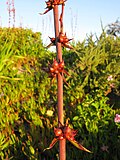interchangeably with "apomixis", and both refer to the formation of sporophytes by parthenogenesis of gametophyte cells. Male apomixis (paternal apomixis) involves...
22 KB (2,740 words) - 00:22, 7 November 2024
plant would be the triploid European dandelion. Apomixis mainly occurs in two forms: In gametophytic apomixis, the embryo arises from an unfertilized egg...
50 KB (5,335 words) - 21:14, 21 October 2024
surrounding the ovaries which form the tough cases around the seeds. Apomixis, setting seed without fertilization, is found naturally in about 2.2% of...
80 KB (6,323 words) - 09:47, 5 November 2024
organisms reproduce asexually via processes such as apomixis, parthenogenesis, autogamy, and cloning. Apomixis and Parthenogenesis both refer to the development...
17 KB (2,079 words) - 22:24, 28 September 2024
Vegetative reproduction (section Apomixis)
entire graft can be clonal if the scion and rootstock are both clones. Apomixis (including apospory and diplospory) is a type of reproduction that does...
24 KB (2,752 words) - 12:48, 1 November 2024
and is distinguished from apomixis, which is a replacement of sexual reproduction, and in some cases involves seeds. Apomixis occurs in many plant species...
26 KB (3,245 words) - 02:29, 28 September 2024
transposable element insertion that causes them to reproduce asexually by apomixis, unlike their sexually-reproducing Ryukyu mandarin parent. This distinctive...
5 KB (428 words) - 12:12, 5 January 2024
Pseudogamy (redirect from Pseudogamous apomixis)
the embryo is not (see Pseudogamous apomixis, below). A better term for the restrictive sense is centrogamy. Apomixis in flowering plants (angiosperms)...
4 KB (560 words) - 17:11, 10 December 2023
Crepis (section Apomixis in Crepis)
with several other genera in Asteraceae, multiple Crepis species exhibit apomixis, a form of asexual reproduction where flowers produce clonal seeds without...
19 KB (1,961 words) - 05:41, 2 November 2024
801–810. doi:10.1111/brv.12367. PMID 28913952. Hörandl E (June 2024). "Apomixis and the paradox of sex in plants". Annals of Botany. 134 (1): 1–18. doi:10...
66 KB (7,650 words) - 11:17, 20 October 2024








